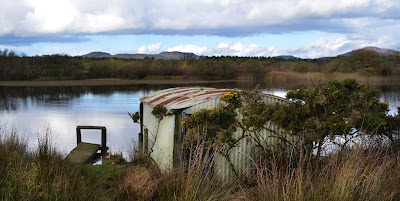I HAVE FINALLY done it.
I have just paid a Glasgow printers for a small print run of The Sleeping Warrior and they are due to arrive hot off the press in a few days.
I have also organised a physical book launch in my home town on 5th December: my very first venture out of Cyberspace and into the real world.
For those who don't enjoy being under public scrutiny, there is a lot to be said about internet promotion. You only need to reveal that part of you that you want others to see; tell the curious what you want to tell them; and package yourself with a virtual smile on your face from a photo you are truly sick of looking at.
There is, however, nowhere to hide in the real world. The stammering, the self-doubt and even the warts all light up like the proverbial Beleshia beacons and, before many expectant faces, there is a tendency for even the most hardened of public orators to implode inwards or run screaming to the taxi rank.
A friend of mine, who is also a very successful writer and has made many a public appearance in her time, gave me the following advice:
"Remember to talk more slowly, have a plan. I either type or write about seven or eight headings to keep me on track. If I'm doing a reading, I time it.
"Remember also that, if folk are sitting there, they're already interested."
She also says to be honest and chatty for the inevitable question time.
Although I may appear quite forthright and confident to most of my friends, I am actually quite shy of strangers and absolutely loathe the idea of selling myself.
To counteract this, I am fortunate enough to have enlisted the aid of another very good friend and a local BBC journalist, Giancarlo Rinaldi, who knows me well and will introduce me on the night. He is funny and interesting and will probably put on such a wonderful performance that people will forget about my book signing and ask him for his autograph instead.
In an ideal world, that would be fine for me as I could sneak out the back door and let out a heavy sigh of relief into the cold Scottish evening.
Debut novels, however, rarely sell themselves and, for the past few weeks, I have been printing out posters and placing them on strategic notice boards around the town. I have also been posting the launch on Twitter, Facebook, KILTR, my writing forums and anywhere else with a bit of blank space.The next move is a press release to the local paper and an interview for an article.
On the day, I'm going to find something to wear that the cat hasn't been sitting on and brave my first public appearance as a new author.
I'll report back on 6th December.
I have just paid a Glasgow printers for a small print run of The Sleeping Warrior and they are due to arrive hot off the press in a few days.
I have also organised a physical book launch in my home town on 5th December: my very first venture out of Cyberspace and into the real world.
For those who don't enjoy being under public scrutiny, there is a lot to be said about internet promotion. You only need to reveal that part of you that you want others to see; tell the curious what you want to tell them; and package yourself with a virtual smile on your face from a photo you are truly sick of looking at.
There is, however, nowhere to hide in the real world. The stammering, the self-doubt and even the warts all light up like the proverbial Beleshia beacons and, before many expectant faces, there is a tendency for even the most hardened of public orators to implode inwards or run screaming to the taxi rank.
A friend of mine, who is also a very successful writer and has made many a public appearance in her time, gave me the following advice:
"Remember to talk more slowly, have a plan. I either type or write about seven or eight headings to keep me on track. If I'm doing a reading, I time it.
"Remember also that, if folk are sitting there, they're already interested."
She also says to be honest and chatty for the inevitable question time.
Although I may appear quite forthright and confident to most of my friends, I am actually quite shy of strangers and absolutely loathe the idea of selling myself.
To counteract this, I am fortunate enough to have enlisted the aid of another very good friend and a local BBC journalist, Giancarlo Rinaldi, who knows me well and will introduce me on the night. He is funny and interesting and will probably put on such a wonderful performance that people will forget about my book signing and ask him for his autograph instead.
In an ideal world, that would be fine for me as I could sneak out the back door and let out a heavy sigh of relief into the cold Scottish evening.
Debut novels, however, rarely sell themselves and, for the past few weeks, I have been printing out posters and placing them on strategic notice boards around the town. I have also been posting the launch on Twitter, Facebook, KILTR, my writing forums and anywhere else with a bit of blank space.The next move is a press release to the local paper and an interview for an article.
On the day, I'm going to find something to wear that the cat hasn't been sitting on and brave my first public appearance as a new author.
I'll report back on 6th December.















